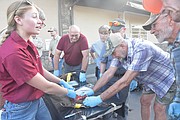Successful hunters can submit samples for CWD testing
For the first time, hunters who harvest a deer, elk or moose in a Chronic Wasting Disease Management Zone in Montana can submit a sample for testing.
Montana Fish, Wildlife and Parks held two clinics last month in Libby and Kalispell for hunters who wanted to learn how to remove the lymph nodes of deer or elk and submit the sample for testing.
FWP Information and Education Program Manager Dillon Tabish said the agency will offer more clinics in the future if there is enough interest.
For now, hunters wishing to have harvested deer, elk and moose tested can submit samples themselves, visit the Libby CWD Sampling Station (Montana Department of Transportation shop on U.S. 2, mile marker 35) on weekends during the general season, which begins Saturday, Oct. 22 and ends Sunday, Nov. 27.
The Libby CWD sampling station is open from 10 a.m. to sunset on Saturday, Sunday and Monday.
Successful hunters can also stop at the FWP office in Kalispell (490 North Meridian) during business hours Monday through Friday.
FWP staff’s ability to collect samples at game check stations will be limited and will occur only if it can be done safely and check stations are not busy.
For hunters who have bagged a moose, the process is a bit more complicated because officials also need the animal’s brain stem for testing.
“We’ll meet up with successful moose hunters to help them get us the sample because it is a more involved process,” said FWP Region 1 CWD Coordinator Lindsey Walden.
At the Libby clinic, about a dozen hunters attended the session to learn how to collect lymph nodes from deer heads that were collected from road-killed animals.
Walden said the do-it-yourself option may be more convenient for hunters who want to save some time between submitting a sample and learning the result.
“You can save some time and if it’s not convenient to come see us, collecting the sample and mailing it in works. And in my mind, if you harvest an animal in the backcountry, you’ll save yourself some weight by deboning the meat and bringing out only what you need or want,” Walden said.
CWD sampling is still voluntary in Montana and FWP is paying for the testing of samples.
Hunters can either take the samples themselves, fill out an online hunter submission form and mail them to the Wildlife Health Lab in Bozeman, or they can bring the animal (or head) to an FWP regional office or CWD Sampling Station this fall.
Hunters can also watch a video on FWP’s website (https://fwp.mt.gov/conservation/chronic-wasting-disease/get-your-animal-sampled) for instructions.
For those who plan to submit samples on their own, the lymph nodes should be double bagged in Ziploc bags or a similar brand bag. The bags should be wrapped in a paper towel.
Hunters are asked to fill out the online form at fwp.mt.gov/cwd and follow directions for labeling the sample. Hunters will receive emails confirming the submission, including one that assigns a unique CWD number so the test result can be tracked. Results will be emailed to hunters on available online in three weeks.
For shipping, the bagged sample (labeled with hunter’s name, phone number and temporary sample ID) and a cold ice pack in a small box or shipping envelope. It is advised to not freeze water in a plastic bag.
Officials also recommend using a carrier that will deliver samples within 24-48 hours to prevent the sample from rotting. They also suggest shipping samples on Monday, Tuesday and Wednesday of each week, and avoid shipping on holidays, to prevent samples from sitting over the weekend.
The shipping address is Montana Fish, Wildlife and Parks, Attn: Wildlife Health Lab (CWD), 1400 S. 19th Ave., Bozeman, MT 59718.
In recent years, FWP has detected CWD in white-tailed deer, mule deer and moose in the Libby area. In Priority Surveillance Areas, sampling is strongly encouraged to help FWP gather additional data to inform management.
Hunters need to be aware of the Libby CWD Management Zone (MZ) and its boundaries, which includes portions of Hunting Districts 100, 103 and 104.
For more information, visit fwp.mt.gov/cwd.



